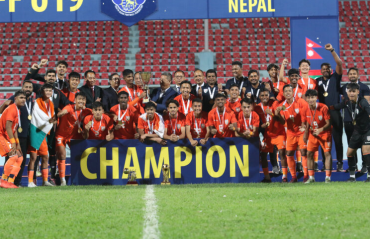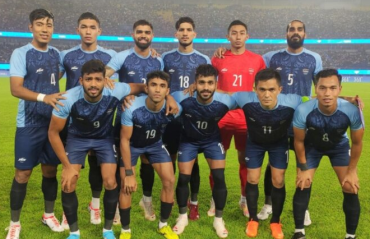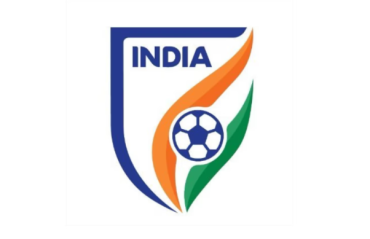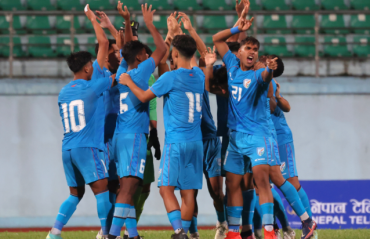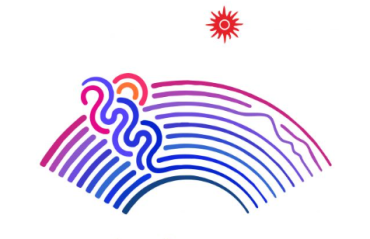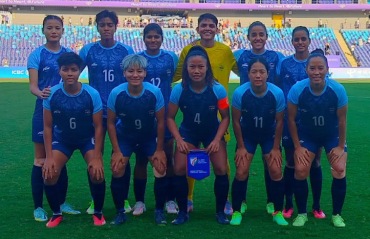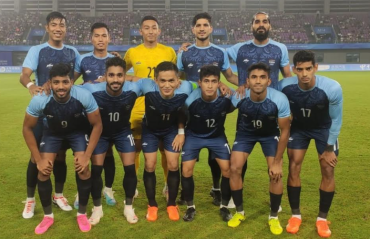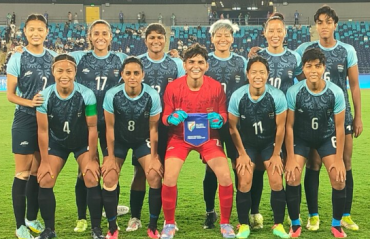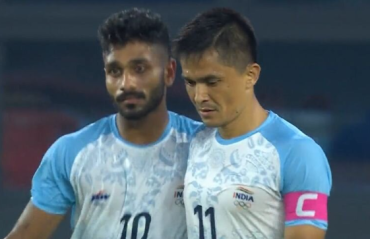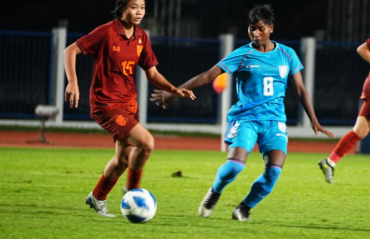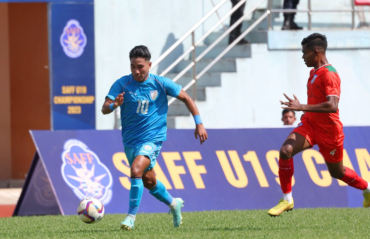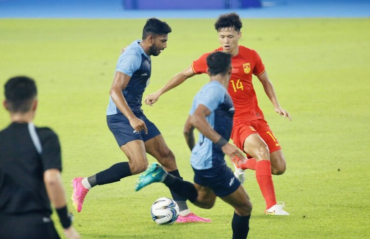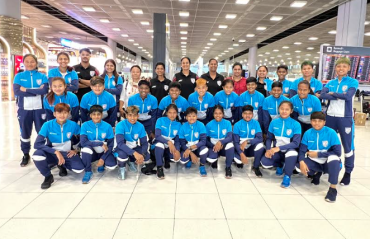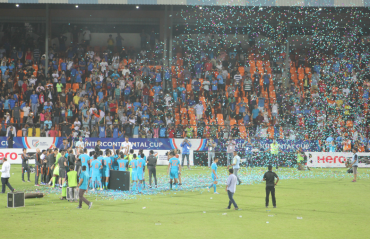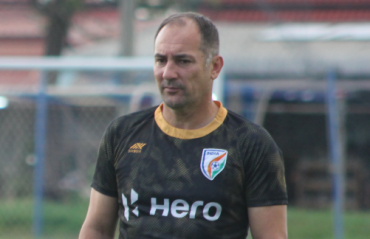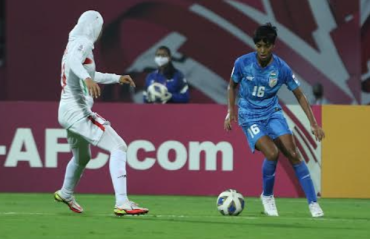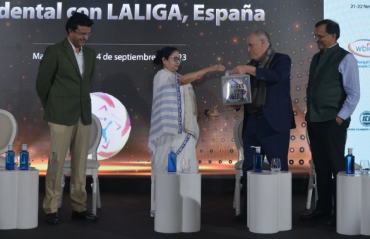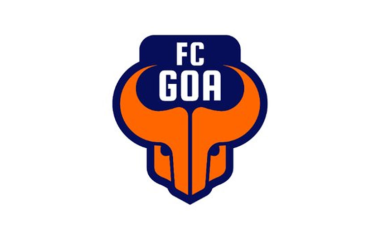SUNBURNT TERRACE -- The I-League is being killed by a series of 'coincidences'
- By Chiranjit Ojha

- June 18, 2019

MAYBE THEY'RE ALL A bunch of wild coincidences.
On Friday and Saturday, two Bengali newspapers Aajkal and Sangbad Pratidin published two reports that claimed some controversial developments were afoot in the AIFF.
The Pratidin article, in particular, had blunt details of what are some of the most scandalous accusations made about AIFF in the history of Indian football. It claimed,
1) The All India Football Federation's commercial partners, Football Sports Development Limited (FSDL, owned by Reliance and Star) are using the ICC Cricket World Cup as a cover to sabotage the I-League with minimal media coverage.
2) FSDL has threatened AIFF with termination of contract and stopped their payments to the Federation, demanding that AIFF must declare ISL as the top division league of India by June 2019. AIFF is convening a meeting to discuss this development.
3) FSDL was angry about AIFF handing out lenient fines (10 lakhs and 5 lakhs) to the I-League clubs who boycotted the Super Cup and wanted AIFF to appeal to its own Disciplinary Committee and ensure the clubs face much harsher fines.
4) FSDL does not want AIFF to let U Mumba FC enter the I-League as a corporate club.
5) FSDL is against broadcasting any I-League match on TV from now on.
When the stories came out, they caused a lot of stir in the Indian football circles. While the I-League clubs braced for the worst and prepared for a possible legal reaction, FSDL-sympathisers raised questions over the authenticity of the claims. They accused the story of speculating too much, and some called it fearmongering by a reporter who had gotten stories wrong in the past.
But then late on Saturday, rumours started floating around that one of the claims made above had in fact come true. The AIFF, in a sudden move, had raised the fines of the I-League clubs who boycotted the Super Cup. So from 5 lakhs, East Bengal's fine was now up to 22.5 lakhs. Minerva Punjab, Gokulam Kerala FC, NEROCA, Churchill Brothers and Aizawl FC were all liable for 27.5 lakhs, up from 10 lakhs. Mohun Bagan have formally appealed against being fined, but they are likely to end up with a similar penalty amount.
It was an extremely unlikely thing for AIFF to second-guess the actions of its own Disciplinary Committee. But they had done it. Does this justify the aforementioned article's claim? No answer from the Federation.
Then, on Sunday morning, another piece of information came out. U Mumba FC, who were supposed to hold trials to recruit local players from Mumbai to play in the I-League 2019-20, received orders directly from AIFF officials to postpone their trials. The Federation was initially enthusiastic about U Mumba wanting to enter I-League, which was guaranteed to boost the league's profile. But suddenly they had done a U-turn from their position. Now, they didn't seem so enthusiastic any more. Is that another act carried out under FSDL's order? No answer from the Federation.
A couple of hours of digging by this reporter also revealed that the I-League clubs, who are currently awaiting official confirmation of their fine hike, still have not received their travel subsidy from the 2018-19 season. Is that because, as the articles claimed, FSDL have blocked the payment to AIFF that was due in April? No answer from the Federation.
A few people close to the situation still wanted to play it down. Don't make too many assumptions, they said on condition of anonimity. Certain things have happened but not for the reasons claimed in the article. There's no pressure from FSDL, AIFF is doing everything on its own accord.
So the claim, put in short, is that unusual u-turn on the Disciplinary Committee's decision, followed by AIFF's logic-defying directive to U Mumba FC to postpone trials (Seriously, when has a Federation ever told an up-and-coming club to not hold trials?)... they are all just coincidences. No connection to the stories that came out.
Sure, that makes sense.
Recently, things have happened; tiny little inconvenient occurences that when tied together seem to add more ground to the long standing theory that AIFF and their commercial partners FSDL (formerly known as IMG-Reliance) were pulling all the stops to suppress the top division league of this country, the I-League, and the clubs that play in it, so that they weaken to the point where the league can be shut down and the FSDL-owned Indian Super League can be declared as the new top division league.
This theory, which is nothing short of an allegation of heavy mismanagement of the national league by the Federation, has been repeatedly shot down by AIFF officials, who called the idea ridiculous and insisted that I-League was a "failed product", which was why the ISL - richer and way more popular - was taking centre-stage, completely organically.
Perhaps they were right. After all, why would a national federation want to sabotage its own national league? The idea, at face value, seems outlandish. Perhaps the situation is not so bad at all; maybe the bitter escalation of the fight between I-League clubs and the AIFF we have seen in recent months was all caused by a terrible misunderstanding due to a wrong interpretation of complete coincidences that happened over the last 9 years.
Let's just take the last 3 months. A lot has happened in Indian domestic football in that time, and most of it has not been good news.
In March, days before the ISL final, Bengaluru FC CEO Parth Jindal told ESPN that ISL teams were losing more money than I-League clubs, and voiced his support for the demand of a unified league as the new top flight of India, as the I-League clubs and most fans in the country have been demanding for years; something which even AFC & FIFA recommendend in their report on the restructuring of the Indian league system.
Not long after the ISL ended, some unflattering rumours started floating around Delhi Dynamos and FC Pune City. Word was that the Dyanmos were moving out of Delhi following poor response from local fans, which the franchise played down. Pune City, meanwhile, made news for missing out on player payments when Iain Hume, followed by Aashique Kuruniyan, approached the AIFF's Player Status Committee to seek justice. Reports also came out that Pune City was on the verge of shutting down, which the franchise tried to spin as "relocating" and "selling stakes."
This was coming on the back of average attendance for most ISL franchises showing a sharp downward turn, including that of ISL's surest bet Kerala Blasters, whose fans boycotted half the season disgruntled by the management's poor handling of transfers and recruitment.
Kerala Blasters 😨😳 , 100cr+ loss in first 4 season. #KeralaBlasters pic.twitter.com/iIRA089pxY
— Fanport (@FanportOfficial) June 1, 2019
Overall, there had never been so much negative press about ISL. Questions were being raised about whether the tournament's franchise fee-centric business model was viable at all, given mounting losses and low returns compared to the huge costs of promoting and marketing the tournament incurred every season.
Meanwhile, I-League for some reason was getting more attention than ever. The top flight league had seen its popularity increase for the seventh straight season, despite having practically no marketing budget, many 2 pm kick-offs and being stuck on Star Sports 3, the channel with the least reach in the whole network. The average attendance had increased for most clubs, and awareness about the top division league was at an all time high due to the success of new clubs like Aizawl FC, NEROCA, Chennai City FC and Real Kashmir FC that brought in new fanbases that never got represented in Indian football before.
Aizawl FC had a fairytale story, winning I-League in 2016-17. Minerva Punjab won the league next season. This season it was Chennai City. All were underdogs who beat the odds to claim the crown, and all title races ended with simultaneous matches where multiple title contender fought till the last minute of the season, making for the most compelling footballing drama of the year; something ISL could not replicate due to its playoffs and lack of a real title race.
The small clubs were actually doing good business too. Aizawl FC made a small profit for a couple of seasons. Real Kashmir FC received a multi-crore grant from the Jammu and Kashmir government, along with a handsome sponsorship deal with Jammu and Kashmir bank. Along with their sold out crowd on matchdays, this made them the most financially secure club in the country. The club was even making news in international media (BBC Scotland produced a documentary on the club) as were Chennai City when Swiss club FC Basel bought stakes in the club.
All of a sudden, to those who were keeping a close eye, the script was flipping. ISL, which was touted by FSDL as the only option for investors to make money and get all the spotlight in Indian football, was no longer the shiny product it once was. And I-League, long sidelined and giddily declared as a failure by AIFF officials, was an object of curiosity.
Sure, for big spenders like City Group, investing in a glamourous franchise like Mumbai City made sense. But for a smart investor, instead of putting heavy money into ISL that guaranteed losses, I-League became a real alternative to ponder upon. They could get into the league via corporate entry on a much lower cost (With a bank guarantee instead of franchise fee), make a team that was much cheaper and bask in the sheer romanticism of travelling around the country, playing matches in places that are beyond the reach of all other commercial tournaments in the country like Mizoram, Kashmir, Manipur... and reach out to communities that were among the most loyal to football in the country.
That was part of the reason why USports, led by Ronnie Screwvala, became interested in playing in I-League. Considered as one of the best sports investors in the country, Screwvala owns U Mumba which participates in the highly successful Pro Kabaddi League. It plays in a table tennis league as well. The company USports has a reputation of investing in leagues that seem like a long shot but end up being a huge success, which is why almost any sporting organization would warmly welcome U Mumba.
According to rumours, USports initially wanted to enter the ISL. But for whatever reason, they set their eyes on I-League at the beginning of 2018-19 season, fielding a team in MDFA Elite Division, setting the stage for an I-League entry, playing out of South Mumbai's historic Cooperage Stadium. A company that knows how to market its teams well, they have also worked closely with Star Sports, which broadcasts the I-League. Surely, that's always a helpful relationship to have, not just for U Mumba FC, but for I-League in general.
In short, U Mumba FC brought nothing but positives to the table. Which is why, it truly makes no sense why AIFF would tell them to stop their trials; a move that has bewildered even U Mumba FC officials, and brought an unnecessary cloud over whether they will enter the I-League at all.
At a time when the image of ISL is suffering, AIFF makes a sudden move that halts the efforts of one of the best sports investors in the country to become a part of I-League. That, too, is just another coincidence, as one says.
It can't be that the article has got a few things right. It certainly is inconceivable that FSDL feels concerned that I-League might rise in popularity and clout and challenge the facade of exclusivity that is at the core of ISL's identity as a product.
Also, remember the fine we mentioned above? The newly raised amount of Rs 27.5 lakhs that most clubs will have to pay? Maybe it's a pure coincidence that the amount has inched closer and closer to Rs 40 lakhs, which is the amount AIFF was supposed to pay the I-League clubs as travel subsidy for the 2018-19 season, but hasn't been able pay because allegedly FSDL has not paid AIFF the first installment of the annual fees.
If the fines coincidentally force a financially struggling club like Minerva Punjab or NEROCA to withdraw from the league, that would be an added bonus... I mean coincidence.
The Indian football landscape today is more volatile that it ever has been. The I-League clubs are ready to go to court over their grievances against AIFF, which the Federation claims are baseless; another bunch of coincidences that are misinterpreted.
But the thread of coincidences is long in this case.
How is it that every season AIFF's League Committee drags its feet over declaring the I-League fixtures and telecast schedules, while ISL fixtures are announced months ahead? The official explanations point to different coincidental reasons every season, but the result is the same every time: I-League clubs have to wait until a couple of weeks before the season starts to know who they will play and when.
As a result of this I-League clubs never get the time to secure good sponsors. Any sponsor in football asks questions like "When are you playing, at what time, which channel will show the match"; simple questions which the clubs can't answer because AIFF doesn't give them the information until it's too late. This results in financial losses for the clubs, and the I-League, regularly.
Officials of rebel clubs have cited this as an example of AIFF's mistreatment of I-League. But of course it could be another co-incidence.
It was also most definitely a coincidence that the League Committee never told the clubs that the broadcasters would only telecasts a limited number of matches in the second half of the season, which embarrassed the clubs in front of sponsors who had been told that all I-League matches would be televised as was the case in 2017-18. Sowing doubt on future matches being televised always helps to coincidentally damage the clubs' prospects of getting good money from sponsors next season.
Another co-incidence would be the fact that the original agreement 2010 between AIFF and FSDL spells out plainly that the Federation's commercial partners have the right to start their own tournament and discontinue the existing I-League and the sudden drop in I-League's marketing and telecast quality from 2011, and their complete lack of any serious effort to promote the league since then. Cynics would see this as an effort to phase out I-League so ISL can take over later, but it could also be a co-incidence.
Then there were the strange allocations of corporate clubs. In 2014-15, AIFF allowed direct entry of Kalyani Bharat FC in Pune, where existing top flight club Pune FC were already struggling to attract the attention of a limited local fanbase, who were mostly turning to FC Pune City thanks to the heavy marketing that ISL got. This move sealed Pune FC's fate; ensuring the owners would shut the club down. Bharat FC also disappeared after just one season.
A similar prospect was raised in Bengaluru, where an idea was floated that Ozone FC would be given a direct entry into I-League, which could complicate things for Bengaluru FC who had just begun to amass a quality fanbase. It may have played a role in Bengaluru FC's eventual decision to join ISL, following which the shadow of Ozone FC magically disappeared. The club in question still plays in the 2nd Division.
It may be a pure coincidence that these moves were made when Pune FC and Bengaluru FC were the only I-League clubs who refused to loan out their players to the inaugural edition of ISL.
The I-League clubs better hope everything listed above is a disconnected occurence, a bunch of coincidences, and not part of a common thread. Because if they are, then other things claimed in the aobvementioned articles may start coming true as well.
AIFF used the India vs Pakistan match in the ongoing ICC Cricket World Cup as a cover to raise the fines on I-League clubs and block U Mumba FC from holding trials. Who knows, when India play England, or reach the semi-finals, the Federation may start implementing the other alleged demands that FSDL have made of them.
AIFF may pile on further punishment on Minerva Punjab's owner Ranjit Bajaj, who has already been in the Federation's crosshairs for multiple controversial and comments. Star Sports may be quietly relieved of their role as broadcasters of I-League. And finally, AIFF may unilaterally declare that I-League will no longer be the top division league from 2019-20 onwards; the prestigious status moving over to the ISL.
A newly minted status of the top division league of India that comes with a spot in the AFC Champions League Qualfiers would certainly help FSDL coincidentally mitigate some of the negative news that FC Pune City's shutdown or Delhi Dynamos FC's abandoning of its original home city is bound to generate.
But if all that happens, what recourse do the I-League clubs have? If ISL becomes top flight and they are not given entry into it, the move effectively relegates all of them to second tier, despite them having earned the right to remain in the top division by their performance on the field.
Ultimately, that's what it is all about. The top division league of India used to be called National Football League, then it was renamed I-League, and no one will mind if it's called ISL in the future with its slew of cash rich franchises being promoted to the status of top division clubs. But the problem lies with forcefully relegating clubs like Chennai City (current Champions of India), East Bengal, Mohun Bagan, Real Kashmir FC, Aizawl FC and others who do not deserve to be relegated by any means. Attempting to relegate them violates every principle of the sport of football. Not that the spirit of football is something the national football federation takes into account too often.
In any case, if AIFF does relegate them, the I-League clubs have no option but to go to court against the decision. The question is, how much of a chance they have.
Here, the situation gets further complicated. The clubs who got into I-League via corporate entry signed a contract with AIFF that explicitly states that if the Federation decides another league will be the new top flight of the country, these teams will not have any claim in being a part of it; they'll have to play in the second tier.
This means Minerva Punjab, Chennai City and Gokulam Kerala have all signed away their claim to play in top flight by right. The only way they can get into ISL is if FSDL allows them to come in through the bidding process. Neither are the clubs interested in paying hefty franchise fees, nor are FSDL overly keen to welcome them into the ISL fold. So we can count that out as a possibility.
When Churchill Brothers re-entered I-League in 2017, coincidentally at the same time when its owner joined the political party where the AIFF president is a prominent leader, they also signed a similar agreement. Which means even their claim is weakened.
It's also possible that Aizawl FC may have entered a similar agreement when their relegation was waived after 2015-16 season. But that's not confirmed. So let's put them down as a "maybe."
This leaves the clubs who have entered the top flight by performance alone, and not by corporate entry or any other non-footballing means. East Bengal, Mohun Bagan, Real Kashmir FC, NEROCA FC and newly promoted TRAU FC from Manipur. These are the clubs which can claim irrefutable grievance if they are forcefully relegated from the top division league to second tier.
Out of them, Real Kashmir will not make a fuss. They even pulled out of the I-League club alliance that boycotted the Super Cup. Rumours are rife that they felt pressure from high places to not join the ranks of the dissidents against AIFF, but that's never been fully substantiated. Whatever the case, their track record indicates they are unlikely to move to court against AIFF.
NEROCA FC are a different story altogether. This summer they lost their princiap sponsors, and are suffering from a financial strife. There is already doubt over whether they will be able to field a team at all next season. Add to this the giant fine of Rs 37.5 lakhs they just got slapped with. It may coincidentally push them over the edge and force them to shut down.
TRAU, meanwhile, are newbies in the big league. And they have not been a part of the ongoing struggle between the I-League clubs and the AIFF. There's a good chance they may want to stay out of this ugly conflict that they did not start, regardless of whether they get to play in the top division league or not.
That leaves only East Bengal and Mohun Bagan in the fray. And that is not a good news for I-League in general. Even the most hardcore fans of EB & MB will readily admit that these clubs always act out of immediate self interest, and have hardly ever looked out for others in post-independence Indian football.
Fans of East Bengal and Mohun Bagan unanimously want to see their clubs play in the ISL.
The recent club elections at MB was fought over this very issue and long time official Tutu Basu won the post of General Secretary on the power of his irrevocable vow to play in the ISL next season. Later, the club officials changed their tune and said they would play in the top division league of the country, whatever it may be called. So if the club gets relegated, regardless of circumstances, the ire of the fans will be directed at not only AIFF but the club officials as well.
East Bengal fans, too, welcomed new investors Quess with open arms because they promised a move to the ISL. In recent months, Quess have made a sudden U-turn on their stance: Chairman Ajit Isaac has come out saying he does not see entering ISL as a smart investment and prefers to play in the top flight I-League for now.
But the fans of these clubs have always been in favour of their clubs entering ISL, knowing full well that sooner or later I-League was going to be discontinued by AIFF. They may tolerate the officials' stance of staying in I-League as long as it remains the top flight, but will not accept a relegation by any means.
EB & MB fans take pride in being the only clubs in India to have participated in every single edition of the top flight national league ever, going all the way back to the inaugural season of NFL in 1996-97. If that status is threatened, they will lash out, and part of the blame will fall on the officials.
So, AIFF and FSDL have I-League clubs backed into a corner. If they make ISL the top flight now, it will trigger the harshest possible response from the clubs. It may lead to a court injuction on the process which will preserve the status quo (I-League as national top division league, ISL as national knockout cup) for one more season.
But if the legal recourse fails, the ground will be removed from under the clubs' feet. Multiple clubs, likely the majority of them, will immediately shut down. And others will descend into internal strife that may significantly weaken them, or be forced to give FSDL what they want: an ISL bid with the promise of a big fat franchise fee.
It will effectively be the end of I-League.
Or, in the words of the powers that be, just another coincidence.









